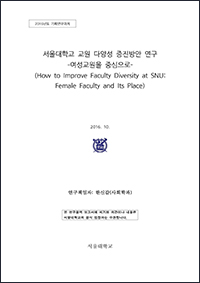[2016 Research Project] How to Improve Faculty Diversity at SNU
16-07-27 17:27페이지 정보
작성자 관리자 작성일16-07-27 17:27 조회1,339회 댓글0건첨부파일
-
 1-1_서울대 교원 다양성 증진 방안 연구.pdf
(13.5M)
134회 다운로드
DATE : 2018-10-31 13:45:29
1-1_서울대 교원 다양성 증진 방안 연구.pdf
(13.5M)
134회 다운로드
DATE : 2018-10-31 13:45:29
관련링크
본문
 |
How to Improve Faculty Diversity at SNU: Female Faculty and Its Place
|
| Necessity and goals of the research |
The composition of its faculty is one of the key resources and driving forces necessary for the effective performance of a university’s functions of research, education, and social service. Therefore, this study focuses on giving opportunities to diverse people so that all people can maximize their individual abilities, and on creating an environment that develops
the collective abilities of the group thus formed. When discussing the composition of a university’s faculty, the problem of female faculty is one of the most important factors, along with that of international faculty. Women make up 22.3% of Tenure-Track Faculty (TF) in South Korean universities as a whole (National Research Foundation of Korea, 2015), and 14.6% of TF at SNU (“2015 Seoul National University Statistical Yearbook”, 2015). Meanwhile, the proportion of women among SNU’s students has steadily increased, reaching 45.5% in the class that entered in 2015.
This underrepresentation of women among faculty not only results in an imbalance of proportions among faculty and students, but also causes problems in other ways and may have profound effects on the university’s organizational culture and decision-making structure. Therefore, securing diversity by increasing the proportion of female faculty may be necessary for the sake of equality, but it is also demanded for the sake of promoting excellence in the university.
Research related to female faculty has been conducted at SNU for the last 10 years, and the goal of “How to Improve Faculty Diversity at SNU” was to continue existing discussions and proposal activities while seeking more practical measures and proposing concrete, realistic policies. From this standpoint, we suggested measures to increase the diversity of SNU’s faculty in the areas of hiring practices and competency development.
| Policy recommendations |
a. Measures to increase appointments of female faculty
First, the problem of how to increase appointments of female faculty must be dealt with based on a clear vision of the value of diversity set forth by the university. We recommend that the university president, who represents SNU both symbolically and in practice, put forth such a vision and exercise leadership in order to achieve it.
Second, at the institutional level, we recommend the adoption of medium-term policies related to the appointment of women at each department. These policies should offer detailed instructions that appropriately reflect the situation of each department. Also, the SNU Committee for Gender Equality must be given the authority to monitor their enactment and take additional steps if necessary.
Third, we recommend amending the article of the Public Education Officials Act related to appointments. The current wording of this article (the “one-third law”) limits the standard of faculty diversity to faculty members’ university of origin. To expand the meaning of diversity, gender and other factors should be included.
b. Competency development for female faculty
First, we recommend operating competency development programs (such as workshops and mentoring) for faculty divided by life stage or job rank. These programs would not be limited to female faculty, and would discuss not only life issues such as childbirth and childcare, but also education and academic activities.
Second, we recommend a regulation stipulating the inclusion of a certain percentage of female faculty in decision-making bodies, and the creation of guidelines for this.
댓글목록
등록된 댓글이 없습니다.